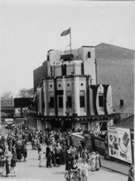| |
Scotland played an important role in the
development of photography, and archives and libraries throughout
Scotland hold collections of old photographs. For information about
the development of photography in Scotland, see below. For a list
of some of the most important collections of photographs relating
to Scotland click
here.
Pioneers
The photographic process was developed in
France and Britain in the 1820s and 1830s, culminating in the glass
negative Daguerreotype process, made public in 1839. St Andrews
played a vital role in the development of the photographic process
through the early interest of Sir David Brewster and his friendship
with Henry Fox Talbot, the inventor of the Calotype process. Early
Scottish photographers included Robert Adamson and David Octavius
Hill, operating from an Edinburgh workshop below the Royal Observatory
in the 1840s. George Washington Wilson, an artist and photographer
based in Aberdeen in the 1850s, took advantage of the Victorian
vogue for views of the Highlands and experimented successfully with
the new wet-collodion process. By the 1880s, through a combination
of technical excellence and business acumen, Wilson’s company had
become the largest and best-known photographic firm in the world.
Other successful commercial photographic companies, from the 1870s
onwards, were Valentines of Dundee, who produced albums of Scottish
views and, later, picture postcards, and Thomas Annan in Glasgow.
Social reformers and municipal photography
Photography had been used to good effect
by social reformers in the late nineteenth century, particularly
in illustrating (through lectures illustrated by glass lantern slide)
problems in industrial cities, such as housing conditions, smoke
nuisance and disease. In the late nineteenth century photography
began to be used by Scotland’s local government bodies and other
municipal institutions to record public undertakings. Glasgow Corporation
had hired Thomas Annan to photograph the completion of the city’s
water supply scheme from Loch Katrine in the 1850s. In the 1860s
and 70s Annan photographed slum housing around the High Street of
Glasgow for the City Improvement Trust, which was about to demolish
the slums to make way for better housing. The work was taken up
by the city’s architects and planners who produced a photographic
record of a century of housing development in the city, while the
city’s Assessor used photographs of buildings as evidence in rates
appeals cases (in the process recording many commercial buildings
in the city in the 1920s and 1930s. Bodies like the Aberdeen Harbour
Board and Clyde Navigation Trust photographed work on improvements
to harbours and river navigation. From 1871 photography was used
by Scottish prison authorities to circulate information about criminals
to police forces.
Proliferation
From the 1870s onwards the proliferation
of photographers’ studios in towns and cities throughout Scotland
made the individual portrait and group photographs affordable for
the middle classes. Industrial firms were among the earliest commercial
users, and some firms specialised in industrial photography. One
of the biggest was William Ralston Ltd, a Glasgow firm founded in
1856, which has been a leading industrial and marine photographer
from 1906 until the present day. Aerial photography developed from
the First World War onwards, primarily for military purposes. Both
the RAF and the Luftwaffe made photographic surveys of Scotland
in the late 1930s and during the Second World War. Newspapers and
magazines began using photographs in the 1930s, and two notable
Scottish photojournalists from the 1940s until the 1970s were Michael
Peto and Oscar Marzaroli. The development of the celluloid negative
and cheaper cameras made photography an affordable part of everyday
life in Scotland from the 1930s onwards.
Links & Bibliography
For a list of websites allowing online photographic
research, see FAQ2 opposite. The following links have information
about the history of photography in general and in Scotland in particular:
St
Andrews University Library
Glasgow
University Library
Aberdeen
University Library and Archives
Royal
Photographic Society
Cecil Beaton and Gay Buckland, The Magic
Image: the genius of photography from 1839 to the present day
(London, 1989);
Helmut Gernsheim, The Concise History of Photography (London,
1986);
Colin Ford (ed), An Early Victorian Album: the photographic masterpieces
(1843-47) of David Octavius Hill and Robert Adamson (New York,
1976);
Colin Ford, The Story of Popular Photography (London, 1989);
Naomi Rosenblum, A World History of Photography (New York,
1997);
David B Thomas, The First Negatives (London, 1964)
|
|
|
|

1.
Can I carry out photographic research online?
2.
Where can I find aerial photographs of places in Scotland?
3.
How do I trace the photograph of a particular ship?
Image 1

A photograph of the Regal Cinema, Stirling,
about 1935 (Scottish Screen Archive, reference: 6/1/253).
|


![]()